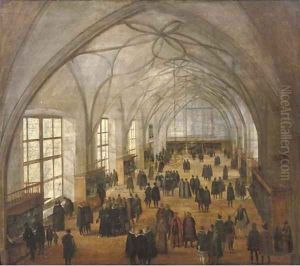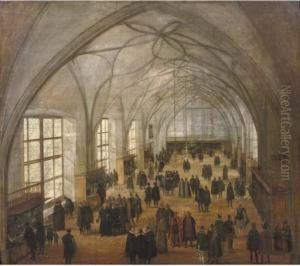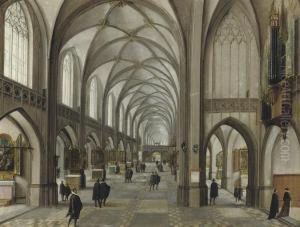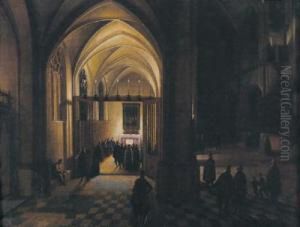Hendrik Van Steenwyck I Paintings
Hendrik Van Steenwyck the Elder, also known as Hendrik Van Steenwyck I, was a Flemish painter born around 1550 in Kampen or Steenwijk in the Northern Netherlands. He is often confused with his son, Hendrik Van Steenwyck the Younger, who was also a painter. Hendrik Van Steenwyck I is primarily known for his contributions to the genre of architectural painting, particularly church interiors.
Van Steenwyck moved to Antwerp and became a citizen of the city in 1573. It is here that he likely received his artistic training and began his career. The Antwerp period of the late 16th century was a vibrant time for artists, and Van Steenwyck was part of this dynamic environment. In 1577, he became a member of the Guild of Saint Luke, which was the city's guild for painters and other artists.
His works often depicted the grand interiors of Gothic churches, rendered with a high degree of accuracy and attention to perspective. Van Steenwyck's painting style was characterized by a meticulous approach to the representation of architectural elements, such as vaults, columns, and arches, as well as the play of light and shadow within these spaces.
His reputation as a master of architectural painting led to significant commissions. In the late 1580s, Van Steenwyck moved to Frankfurt am Main, where he continued to work and received patronage from the city's wealthy merchants and city officials. The move to Frankfurt was likely due to the troubled political situation in the Low Countries, which were at the time embroiled in the Eighty Years' War.
Hendrik Van Steenwyck I's influence extended beyond his own practice. His son, Hendrik Van Steenwyck II, followed in his footsteps and became a successful architectural painter as well. The younger Steenwyck moved to London and established his own reputation, working for the English court.
Hendrik Van Steenwyck I died in Frankfurt in 1603. His work left a lasting legacy on the genre of architectural painting, and his techniques would be studied and emulated by subsequent generations of artists. Today, his paintings can be found in museums and collections across the world, offering viewers a glimpse into the grandeur of Renaissance architecture as captured through the eyes of a highly skilled painter.



